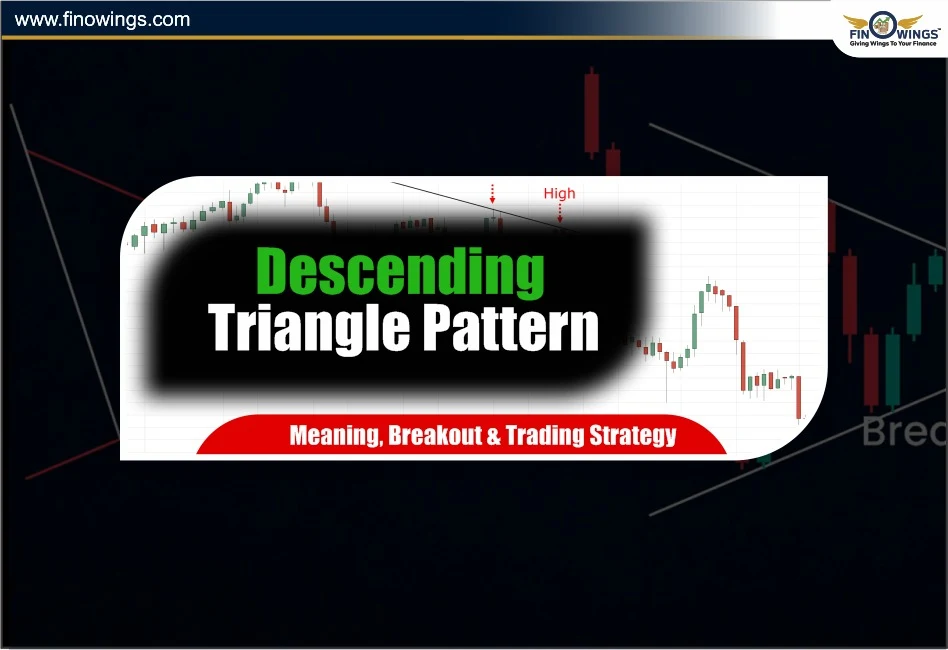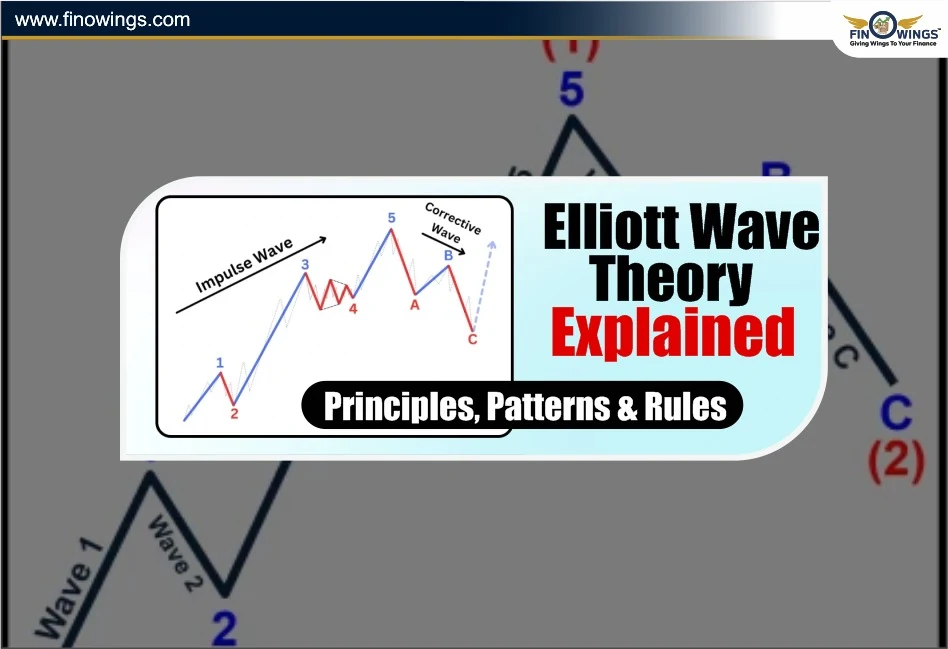Home >> Blog >> Descending Triangle Pattern: Meaning, Breakout & Trading Strategy
Descending Triangle Pattern: Meaning, Breakout & Trading Strategy

Table of Contents
- What Is a Descending Triangle Pattern?
- Formation of a Descending Triangle Chart Pattern
- Descending Triangle Pattern in Downtrend
- Descending Triangle Pattern In Uptrend
- Descending Flag Pattern vs. Descending Triangle Pattern
- Triangle Breakout and Triangle Confirmation
- How to Trade the Descending Triangle Pattern
- Example of Descending Triangle Pattern Stock Analysis
- Conclusion
Different types of triangle patterns serve as the most accurate chart formations. One of the most well-known patterns is the Descending Triangle Pattern, which can function as a bearish continuation pattern, indicating that the price movement will continue in the same direction as the preceding trend.
This chart pattern can also help you identify and set targets and breakouts, meaning you can manage risk effectively regardless of which financial market you are trading in - stocks, forex, or cryptocurrencies.
What Is a Descending Triangle Pattern?
A descending triangle pattern is a type of bearish continuation pattern that develops on a price chart during a downtrend. The price consolidates, forming a pattern of a triangle by bouncing off a horizontal support line, which favours the sellers in the order of consolidation, sloping down diagonally against the winning buyer.
This pattern starts hinting at consolidation at lower prices in a market and the price is set to break lower. The price is likely to continue lower (mid-range downtrend continuation of downtrend).
This pattern resembles a slanted triangle where the support line forms the horizontal line of the triangle as the ranged support and the line of resistance tapers downwards, forming the slanted upper line.
Though overall this pattern shows it is likely the price will continue down and is a bearish signal pattern, in rare cases, it can signal a descending triangle pattern bullish breakout where this overall pattern is bullish for the market.
Formation of a Descending Triangle Chart Pattern
A descending triangle chart pattern is produced by the following actions of the price chart:
1. Downward Sloping Resistance Line - This is drawn by a series of lower highs formed by selling pressure.
2. Horizontal Support Line - This shows the price point at which buyers enter and halt the decline.
3. Converging Price Movement - As time goes on, the price is forced between the two lines, which significantly lowers volatility.
4. Breakout Point - When the price eventually exits the triangle, it typically does so in a downward direction, resulting in a dramatic shift.
This formation is simply part of the descending pattern family which includes falling triangle patterns and other bearish setups.
Descending Triangle Pattern in Downtrend
In a downtrend, a descending triangle pattern is categorized as a continuation pattern, meaning it reinforces the bearish trend.
This is how it plays out:
-
The market is in a decline.
-
The consolidation phase has lower highs and flat support.
-
The sellers progressively dominate, and the volume tapers off.
-
Eventually, a descending triangle pattern breakout occurs at the support line, resulting in more selling.
-
A breakdown like this usually indicates another leg down on the downtrend, providing traders with an opportunity to enter or scale up on short positions.
(Source: Groww)
Descending Triangle Pattern In Uptrend
Occasionally, the descending triangle pattern in an uptrend can act as a reversal signal instead of a continuation.
Here, the pattern arises after a significant advance:
The market starts to create lower highs (a sign of weakening upward momentum).
A flat support line portrays temporary buying interest.
If the support line is broken, the pattern confirms the reversal of the trend.
Rarely, buyers can be strong enough to produce a true descending triangle pattern bullish breakout. This occurs when the breakout takes place above the descending resistance line.
(Source: TradingView)
Descending Flag Pattern vs. Descending Triangle Pattern
While both patterns might appear similar, they indicate completely different structures in the market.
|
Feature |
Descending Flag Pattern |
Descending Triangle Pattern |
|
Shape |
Downward parallel channel |
Downward sloping upper line & flat base |
|
Nature |
Continuation pattern |
Continuation (sometimes reversal) |
|
Slope |
Both lines slope down |
One sloping, one flat |
|
Volume |
Decreases during formation |
Declines, then spikes on breakout |
|
Breakout Direction |
Usually upward (bullish) |
Usually downward (bearish) |
Therefore, a descending flag pattern predicts a bullish continuation, while the descending triangle pattern usually confirms that bearish momentum is in play.
Triangle Breakout and Triangle Confirmation
Triangle breakout patterns are the most important patterns to understand when trading any triangle formation.
A breakthrough in a descending triangle formation typically occurs below the support line, indicating that selling pressure is probably going to persist.
To confirm a breakout in a descending triangle pattern:
1. Price closes down below the support line (not just temporarily during the day).
2. A Volume spike takes place during the breakout.
3. A Retest of broken support occurs (turned into resistance).
After confirming the breakout, traders often place a direct target equal to the height of the triangle from the breakout point.
How to Trade the Descending Triangle Pattern
Use these steps to execute your descending triangle pattern trading strategy:
1. Identify the Pattern
Draw trendlines around the lower highs and the flat support. Make sure that you have two touches on each trendline.
2. Wait for the Breakout
Don’t jump in too early. Wait for the triangle pattern breakout to occur first.
3. Enter the Trade
Bearish Setup: Enter a short trade after a confirmed close below the support.
Bullish Setup: This setup is rare, but you would enter a long position if the price breaks above the resistance line.
4. Configure your Stop Loss
When you're doing short trades, place your stop loss just above the last lower high. For long trades, place it below the last swing low.
5. Determine Profit Targets
To find the profit target, we can use the following formula:
Profit Target = Height of the Triangle (at its widest point) +/- Breakout Point.
For example, the height of the triangle is ₹20, and the breakout occurs at ₹180. The new target on the downside will be ₹160.
Example of Descending Triangle Pattern Stock Analysis
Suppose a stock is ₹500 and it goes down to ₹450 (downtrend) and then consolidates:
Lower highs form around ₹480, ₹470, and ₹460. There is strong support at ₹450. Volume keeps dropping during this phase. Once the price drops below ₹450 with high volume, it confirms a descending triangle pattern breakout. Traders can short the stock at ₹445 and set the target around ₹395 (this target can vary depending on the height of the triangle).
Tips for Effective Triangle Breakout Trading
-
For the most reliable signals, use higher timeframes (think daily or weekly charts).
-
To confirm momentum, use Pitchfork analysis with the RSI or MACD.
-
Never stop loss.
-
During low volume sessions, you can encounter false breakouts and you want to avoid those.
-
Look for retests because they sometimes yield better risk-to-reward ratio entries.
Conclusion
The descending triangle pattern is a staple in technical analysis and indicates a continuation of a downtrend. However, it is not a definitive formation. It can appear during uptrends and signal a reversal. By mastering this triangle breakout pattern, traders can efficiently maximise risk while minimising it and time entries and exits more accurately.
If you see a falling triangle pattern or a descending triangle pattern in downtrend, remember to verify the breakout with volume. It takes practice and discipline, but this pattern can become one of your best friends in trading.
The Cup and Handle Pattern is another well-liked shape that indicates a bullish continuation following consolidation if you're looking for other trustworthy chart patterns. To learn how traders use the Cup and Handle Pattern to spot possible breakout possibilities, check out our comprehensive tutorial.
DISCLAIMER: This blog is NOT any buy or sell recommendation. No investment or trading advice is given. The content is purely for educational and information purposes only. Always consult your eligible financial advisor for investment-related decisions.


















